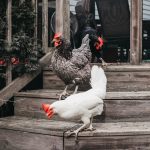Winter care for chickens requires understanding their specific needs based on breed, age, and environmental conditions. Some chicken breeds, like Rhode Island Red, Orpington, and Wyandotte, are more cold-hardy than others, such as Silkie and Polish breeds. Younger birds and older hens may be more vulnerable to cold weather.
The local climate, including average temperatures, wind chill, and precipitation levels, also influences the level of care required. In regions with harsh winters and heavy snowfall, extra precautions are necessary to keep chickens warm and dry. Milder climates may require less intensive winter care.
By considering these factors, chicken owners can develop a tailored approach to winter care that addresses the specific needs of their flock and local conditions.
Table of Contents
- 1 Providing Proper Shelter
- 2 Insulating the Coop
- 3 Using Heat Lamps or Heaters
- 4 Ensuring Proper Ventilation
- 5 Offering Warm Bedding
- 6 Monitoring Your Chickens’ Health
- 7 FAQs
- 7.1 What are the best ways to keep chickens warm in cold weather?
- 7.2 What temperature is too cold for chickens?
- 7.3 How can I insulate my chicken coop to keep it warm?
- 7.4 Are there any specific breeds of chickens that are better suited for cold weather?
- 7.5 Is it safe to use heat lamps or heaters in a chicken coop?
Key Takeaways
- Understanding the needs of your chickens is crucial for their well-being and productivity.
- Providing proper shelter is essential to protect your chickens from harsh weather conditions and predators.
- Insulating the coop can help maintain a comfortable temperature for your chickens during cold weather.
- Using heat lamps or heaters can be beneficial in keeping your chickens warm, but caution must be taken to prevent fire hazards.
- Ensuring proper ventilation is important to maintain good air quality and prevent moisture buildup in the coop.
- Offering warm bedding such as straw or wood shavings can help keep your chickens comfortable during colder months.
- Monitoring your chickens’ health regularly is important to catch any signs of illness or distress early on.
Providing Proper Shelter
Size and Ventilation Matter
A well-built coop is essential for protecting your flock from the cold, wind, and moisture. When designing or selecting a coop for your chickens, it’s important to consider factors such as size and ventilation. The coop should be spacious enough to allow for adequate airflow while still providing enough room for all of your chickens to roost comfortably. Additionally, the coop should be well-ventilated to prevent the buildup of moisture, which can lead to respiratory issues in chickens.
Insulation is Key
In addition to size and ventilation, insulation is a key factor in providing proper shelter for your chickens during the winter. Insulating the walls and roof of the coop can help retain heat and keep out drafts, creating a more comfortable environment for your flock. This can be achieved through the use of insulation materials such as foam board or fiberglass batts.
Proper Installation is Crucial
It’s important to ensure that the insulation is installed properly and securely to prevent any potential hazards to your chickens. By providing your flock with a well-built and insulated coop, you can help protect them from the harsh winter weather and create a safe and comfortable living space.
Insulating the Coop
Insulating the coop is an essential step in preparing your chickens for the winter months. Proper insulation can help regulate the temperature inside the coop, keeping it warm and comfortable for your flock. There are several methods for insulating a chicken coop, including adding insulation to the walls and roof, sealing any drafts or gaps, and using materials such as straw or hay for additional warmth.
Insulation materials such as foam board or fiberglass batts can be installed inside the walls and roof of the coop to help retain heat and keep out drafts. It’s important to ensure that the insulation is installed securely and does not pose any safety hazards to your chickens. In addition to traditional insulation methods, using natural materials such as straw or hay can also provide added warmth and comfort for your chickens.
These materials can be spread on the floor of the coop to create a cozy bedding area for your flock. Not only do they provide insulation, but they also absorb moisture and provide a soft surface for your chickens to roost on. When using natural materials for insulation, it’s important to regularly clean and replace them to prevent mold or mildew from developing.
By insulating your chicken coop using a combination of traditional insulation methods and natural materials, you can create a warm and comfortable environment for your flock to thrive in during the winter months.
Using Heat Lamps or Heaters
In some cases, especially in regions with extremely cold temperatures, using heat lamps or heaters may be necessary to provide additional warmth for your chickens during the winter. Heat lamps can be installed in the coop to provide a source of heat, while heaters can be used to warm the air inside the coop. When using heat lamps or heaters, it’s important to follow safety precautions to prevent any potential fire hazards.
Ensure that all electrical equipment is properly installed and secured, and keep them away from any flammable materials such as straw or hay bedding. It’s also important to monitor the temperature inside the coop when using heat lamps or heaters to prevent overheating. Using a thermometer can help you regulate the temperature and ensure that it stays within a safe range for your chickens.
Additionally, it’s important to provide a balance between warmth and fresh air by maintaining proper ventilation in the coop. While heat lamps or heaters can provide additional warmth for your flock during the winter, it’s important to use them cautiously and in conjunction with other methods of insulation and shelter.
Ensuring Proper Ventilation
Proper ventilation is crucial for maintaining a healthy environment inside the chicken coop during the winter months. While it may seem counterintuitive to allow fresh air into the coop during cold weather, adequate ventilation is essential for preventing moisture buildup and maintaining good air quality for your flock. Poor ventilation can lead to respiratory issues in chickens, as well as an increased risk of mold and mildew growth inside the coop.
To ensure proper ventilation in the coop, consider installing vents or windows that can be opened and closed as needed to regulate airflow. Additionally, it’s important to regularly clean out any bedding or litter that may become damp or soiled, as this can contribute to poor air quality inside the coop. By maintaining proper ventilation in the chicken coop, you can help prevent respiratory issues and create a healthier living environment for your flock during the winter months.
Offering Warm Bedding

Insulation and Comfort
Bedding materials such as straw, hay, or wood shavings can help insulate the floor of the coop and provide a comfortable roosting area for your flock. These materials also absorb moisture and help keep the coop dry, which is essential for preventing frostbite and other cold-related health issues in chickens.
Selecting the Right Bedding Materials
When selecting bedding materials for your chicken coop, consider using thick layers of straw or hay to provide maximum insulation and warmth for your flock.
Maintenance and Hygiene
It’s important to regularly clean and replace bedding materials to prevent mold or mildew from developing, as well as to maintain a clean and healthy living environment for your chickens. By offering warm bedding in the coop, you can help keep your flock comfortable and protected from the cold weather during the winter months.
Monitoring Your Chickens’ Health
Finally, it’s important to monitor your chickens’ health closely during the winter months to ensure that they are thriving in their environment. Keep an eye out for signs of cold-related health issues such as frostbite, respiratory problems, or decreased egg production. Additionally, pay attention to any changes in behavior or appetite that may indicate that your chickens are not adjusting well to the winter conditions.
Regular health checks can help you identify any potential issues early on and take appropriate measures to address them. Providing a balanced diet with plenty of nutrients and access to fresh water is also essential for supporting your chickens’ overall health during the winter months. By monitoring your chickens’ health and providing them with proper care and attention, you can help ensure that they stay happy and healthy throughout the colder seasons.
In conclusion, caring for chickens during the winter requires careful consideration of their specific needs and environmental conditions. By providing proper shelter, insulation, warmth, ventilation, bedding, and monitoring their health closely, you can help ensure that your flock stays healthy and comfortable throughout the colder months. With thoughtful preparation and attentive care, you can create a safe and nurturing environment for your chickens to thrive in during the winter season.
If you’re looking for more information on keeping your chickens warm, you might want to check out this article on turning a shed into a chicken coop. It offers valuable tips on creating a cozy and insulated space for your feathered friends during the colder months.
FAQs
What are the best ways to keep chickens warm in cold weather?
Some of the best ways to keep chickens warm in cold weather include providing a well-insulated coop, using heat lamps or heaters, providing extra bedding, and ensuring good ventilation.
What temperature is too cold for chickens?
Chickens can tolerate cold temperatures quite well, but they start to feel uncomfortable when the temperature drops below 0°F (-18°C). It’s important to provide them with a warm and dry environment to prevent any cold-related health issues.
How can I insulate my chicken coop to keep it warm?
You can insulate your chicken coop by using materials such as foam board, straw bales, or reflective insulation. Make sure to insulate the walls, ceiling, and floor to keep the warmth inside the coop.
Are there any specific breeds of chickens that are better suited for cold weather?
Yes, some chicken breeds are better suited for cold weather than others. Breeds such as the Rhode Island Red, Plymouth Rock, and Orpington are known for their cold-hardiness and can withstand colder temperatures better than other breeds.
Is it safe to use heat lamps or heaters in a chicken coop?
Yes, it is safe to use heat lamps or heaters in a chicken coop as long as they are installed properly and used according to the manufacturer’s instructions. It’s important to keep them away from flammable materials and to regularly check for any malfunctions.
Meet Walter, the feathered-friend fanatic of Florida! Nestled in the sunshine state, Walter struts through life with his feathered companions, clucking his way to happiness. With a coop that’s fancier than a five-star hotel, he’s the Don Juan of the chicken world. When he’s not teaching his hens to do the cha-cha, you’ll find him in a heated debate with his prized rooster, Sir Clucks-a-Lot. Walter’s poultry passion is no yolk; he’s the sunny-side-up guy you never knew you needed in your flock of friends!







